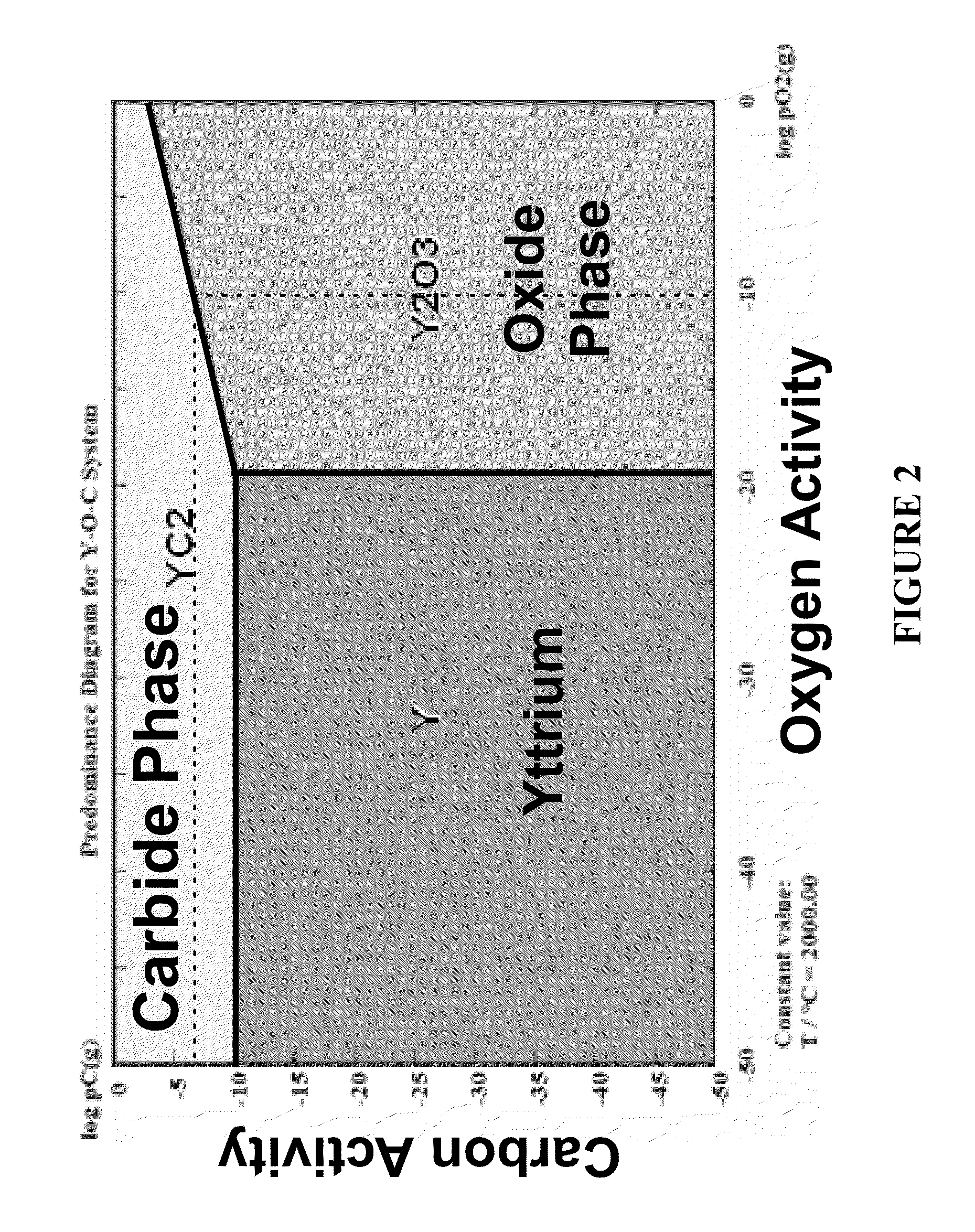Porous pyrolysis reactor materials and methods
a pyrolysis reactor and porous technology, applied in the direction of liquid-gas reaction of thin-film type, gas-gas reaction process, physical/chemical process catalyst, etc., can solve the problems of high temperature reaction, high temperature and process stress, and specialized equipment to tolerate intense heat and physical stress conditions, etc., to achieve the long-term viability of most conventional apparatus
- Summary
- Abstract
- Description
- Claims
- Application Information
AI Technical Summary
Benefits of technology
Problems solved by technology
Method used
Image
Examples
example 1
[0074](Exemplary refractory material, but no formed porosity.) An yttria ceramic composition was prepared by mixing 50 wt % of the first grit Amperit 849.054 Y2O3 powder (H.C. Starck), 30 wt % of the second grit Y2O3 powder (1 μm average particle size, 99.9%, from Alfa Aesar) and 20 wt % of the third grit Grade C Y2O3 powder (H.C. Starck). About 30 wt % additional organic binder was mixed with the ceramic powder to provide green body strength during forming process. The powder was extruded into a honeycomb shape (300 cpsi) in the size of about ¾″ diameter×1.0″ thickness. The extruded honeycomb green body was then sintered at 1600° C. for 4 hours in air and annealed at 1900° C. for 4 hours in argon to form a fired ceramic body. The resultant yttria ceramic body was also comprised of about 15 vol % porosity mainly derived from the first grit Amperit 849.054 Y2O3 powder. This residual porosity provides thermal shock resistance. The produced yttria honeycomb sample was tested in a rever...
example 2
[0075](Exemplary refractory material with porosity.) 75 vol % of coarse grit (−105+44 μm particle size range) of stabilized zirconia powder (10˜15% Y2O3, from Alfa Aesar) and 10 vol % of fine grit (1 μm D50 average particle size) of Y2O3 powder (99.9%, from Alfa Aesar) were mixed with 15 vol % polymeric micro beads (15 μm diameter Spheromers® CA15, from Micro beads AS, Norway) by use of HDPE milling jar. The mixture was milled for 10 hours without milling media in a ball mill at 100 rpm. Water was removed from the mixed powders by heating on a hot plate. The dried powder mix was compacted in a 40 mm diameter die in a hydraulic uniaxial press (SPEX 3630 Automated X-press) at 5,000 psi. The resulting green disc pellet was ramped up to 800° C. at 25° C. / min in air and held at 800° C. for 2 hrs to decompose polymeric micro beads and then heated to 1600° C. in air and held at 1600° C. for 4 hours. The temperature was then reduced to below 100° C. at −15° C. / min. The resultant refractory ...
example 3
[0076](Exemplary refractory material with porosity.) Fine Y2O3 powder (H.C. Starck, Grade C; D90=2.5 μm, D50=0.9 μm, D10=0.4 μm) was mixed with 15 vol % polymeric micro beads (15 μm diameter Spheromers® CA15, from Micro beads AS, Norway) in water by use of HDPE milling jar. The mixture was milled for 10 hours without milling media in a ball mill at 100 rpm. The water was removed from the mixed powders by heating on a hot plate. The dried powder mix was compacted in a 40 mm diameter die in a hydraulic uniaxial press (SPEX 3630 Automated X-press) at 5,000 psi. The temperature of the resulting green disc pellet was ramped up to 800° C. at 25° C. / min in air and held at 800° C. for 2 hrs to decompose and vaporize the polymeric beads and then heated to 1600° C. in air and held at 1600° C. for 4 hours to sinter the disk pellet. The temperature was then reduced to below 100° C. at −15° C. / min. The resultant refractory ceramics with uniformly dispersed micro pores comprised: i) 73 vol % yttr...
PUM
| Property | Measurement | Unit |
|---|---|---|
| temperature | aaaaa | aaaaa |
| pressure | aaaaa | aaaaa |
| pressure | aaaaa | aaaaa |
Abstract
Description
Claims
Application Information
 Login to View More
Login to View More - R&D
- Intellectual Property
- Life Sciences
- Materials
- Tech Scout
- Unparalleled Data Quality
- Higher Quality Content
- 60% Fewer Hallucinations
Browse by: Latest US Patents, China's latest patents, Technical Efficacy Thesaurus, Application Domain, Technology Topic, Popular Technical Reports.
© 2025 PatSnap. All rights reserved.Legal|Privacy policy|Modern Slavery Act Transparency Statement|Sitemap|About US| Contact US: help@patsnap.com



